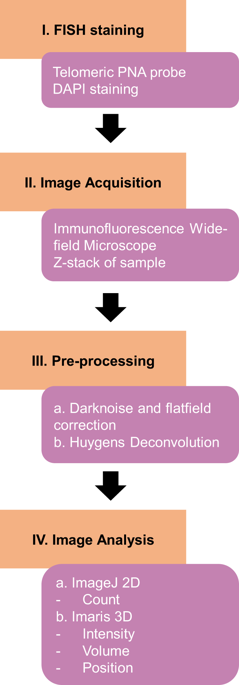当前位置:
X-MOL 学术
›
Commun. Biol.
›
论文详情
Our official English website, www.x-mol.net, welcomes your
feedback! (Note: you will need to create a separate account there.)
Telomere analysis using 3D fluorescence microscopy suggests mammalian telomere clustering in hTERT-immortalized Hs68 fibroblasts.
Communications Biology ( IF 5.2 ) Pub Date : 2019-12-04 , DOI: 10.1038/s42003-019-0692-z Nancy Adam 1 , Erin Degelman 2 , Sophie Briggs 1 , Rima-Marie Wazen 3 , Pina Colarusso 3, 4 , Karl Riabowol 1, 5 , Tara Beattie 1
Communications Biology ( IF 5.2 ) Pub Date : 2019-12-04 , DOI: 10.1038/s42003-019-0692-z Nancy Adam 1 , Erin Degelman 2 , Sophie Briggs 1 , Rima-Marie Wazen 3 , Pina Colarusso 3, 4 , Karl Riabowol 1, 5 , Tara Beattie 1
Affiliation

|
Telomere length and dynamics are central to understanding cell aging, genomic instability and cancer. Currently, there are limited guidelines for analyzing telomeric features in 3D using different cellular models. Image processing for telomere analysis is of increasing interest in many fields, however a lack of standardization can make comparisons and reproducibility an issue. Here we provide a user's guide for quantitative immunofluorescence microscopy of telomeres in interphase cells that covers image acquisition, processing and analysis. Strategies for determining telomere size and number are identified using normal human diploid Hs68 fibroblasts. We demonstrate how to accurately determine telomere number, length, volume, and degree of clustering using quantitative immunofluorescence. Using this workflow, we make the unexpected observation that hTERT-immortalized Hs68 cells with longer telomeres have fewer resolvable telomeres in interphase. Rigorous quantification indicates that this is due to telomeric clustering, leading to systematic underestimation of telomere number and overestimation of telomere size.
中文翻译:

使用 3D 荧光显微镜进行的端粒分析表明哺乳动物端粒聚集在 hTERT 永生化 Hs68 成纤维细胞中。
端粒长度和动态对于理解细胞衰老、基因组不稳定性和癌症至关重要。目前,使用不同细胞模型分析 3D 端粒特征的指南有限。用于端粒分析的图像处理在许多领域越来越受到关注,但缺乏标准化可能会使比较和再现性成为问题。在这里,我们提供了间期细胞端粒定量免疫荧光显微镜用户指南,涵盖图像采集、处理和分析。使用正常人二倍体 Hs68 成纤维细胞确定确定端粒大小和数量的策略。我们演示了如何使用定量免疫荧光准确确定端粒数量、长度、体积和聚类程度。使用此工作流程,我们意外地观察到端粒较长的 hTERT 永生化 Hs68 细胞在间期的可解析端粒较少。严格的量化表明,这是由于端粒聚集造成的,导致端粒数量的系统性低估和端粒大小的高估。
更新日期:2019-12-04
中文翻译:

使用 3D 荧光显微镜进行的端粒分析表明哺乳动物端粒聚集在 hTERT 永生化 Hs68 成纤维细胞中。
端粒长度和动态对于理解细胞衰老、基因组不稳定性和癌症至关重要。目前,使用不同细胞模型分析 3D 端粒特征的指南有限。用于端粒分析的图像处理在许多领域越来越受到关注,但缺乏标准化可能会使比较和再现性成为问题。在这里,我们提供了间期细胞端粒定量免疫荧光显微镜用户指南,涵盖图像采集、处理和分析。使用正常人二倍体 Hs68 成纤维细胞确定确定端粒大小和数量的策略。我们演示了如何使用定量免疫荧光准确确定端粒数量、长度、体积和聚类程度。使用此工作流程,我们意外地观察到端粒较长的 hTERT 永生化 Hs68 细胞在间期的可解析端粒较少。严格的量化表明,这是由于端粒聚集造成的,导致端粒数量的系统性低估和端粒大小的高估。











































 京公网安备 11010802027423号
京公网安备 11010802027423号